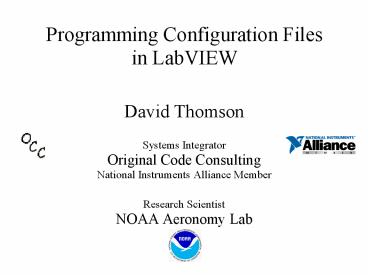Programming Configuration Files in LabVIEW - PowerPoint PPT Presentation
1 / 18
Title:
Programming Configuration Files in LabVIEW
Description:
Flatten each cluster to a string ... Cluster names and key names contain redundant data ... the Control Ref for the cluster to parse the parameters, using ... – PowerPoint PPT presentation
Number of Views:262
Avg rating:3.0/5.0
Title: Programming Configuration Files in LabVIEW
1
Programming Configuration Filesin LabVIEW
- David Thomson
- Systems Integrator
- Original Code Consulting
- National Instruments Alliance Member
- Research Scientist
- NOAA Aeronomy Lab
2
Configuration Management
- Ideally, a project is completely designed before
any programming begins - In (my) reality, the software must often evolve
as hardware is developed - In order to maintain flexibility, many parameters
are stored in a configuration file rather than
hard-coded - How can these configuration parameters to stored
and managed as the project evolves?
3
Configuration File Methods in LV
- Save front-panel defaults
- Binary files (write a cluster or clusters of
parameters directly to a file) - Save parameters in the Windows Registry
- Use the Configuration (.ini) File VIs
- Other ideas?
4
Save Front Panel Defaults
- Useful for small programs that don't need much
configuration management - Use VI Server
- Does not work in built executables or on running
VIs - See Save Defaults at www.originalcode.com for
a simple implementation
5
Binary File (Single Cluster)
- Wire a cluster of parameters directly to the
Write File primitive - Very simple to implement
- Limited to a single cluster
- Can't write different cluster types to the same
binary file - Extremely large clusters can excede LabVIEW's
capacity - Hard to maintain as parameters are added
- Old files can not be read once the cluster has
changed
6
Multiple Clusters
- If the number of parameters excedes the capacity
of a single cluster, write multiple clusters to a
binary file - Flatten each cluster to a string
- Prepend the string with a flattened string
containing the length of the cluster string - Multiple strings can be written, then read by
first reading the string length, then the
clusters unflattened
7
Multiple Clusters
- Very difficult to maintain as the parameters
change - Fairly convoluted diagram for reading and writing
the clusters
8
Saving to the Windows Registry
- LabVIEW VIs are provided for reading and writing
registry keys since LV 6.0 - No examples provided here
- There is inherent danger in messing with the
registry - This has been discussed extensively on
Info-LabVIEW (search the archives)
9
Configuration (.ini) Files
- Since LV 5.1, there have been VIs for reading and
writing .ini files - Improved significantly (polymorphic) in recent
versions - Creates human-readable files
- New keys can be added at any time
- Old keys can be ignored
- Can handle default values for missing keys
10
Configuration (.ini) Files
- Four variations presented here
- Basic
- Easy-to-Maintain Version
- Automated using Control References
- Automated using Variants
11
Basic Configuration File
- Diagram is simple, but gets big fast
- Cluster names and key names contain redundant
data - Can automatically create the configuration file
the first time using the default values - Must make sure the writer and reader are always
synchronized with each other when parameters are
added or changed
12
Easy-to-Maintain Config Files
- Developed by David Thomson and Scott McLaughlin
(formerly of NOAA ETL, now with Applied
Technologies) - One VI that reads and writes
- Eliminates problems synchronizing names in two
VIs - Wrap the polymorphic Config VIs into a
polymorphic Read/Write VI - Case structure makes the diagram more managable
13
Easy-to-Maintain Config Files
- Use of Type-def Enum and Unbundling techniques
add automatic error checking when more parameters
are added - Can automatically parse cluster and parameter
names to generate section and key names
14
Automated using Control Refs
- Developed by Jim Kring
- see www.openg.org for more information
- Uses the Control Ref for the cluster to parse the
parameters, using labels for Section and Key
names - No new programming needed when new parameters are
added (assuming flat clusters or arrays of
clusters)
15
Automated using Control Refs
- Default values are handled differently
- Other structures not yet implemented would have
to be programmed - Clever implementation, but now supplanted by the
next example
16
Automated using Variants
- Developed by Jim Kring and Jean-Pierre Drolet
- See www.openg.org for more information
- http//sourceforge.net/projects/opengtoolkit for
downloads - Requires additional toolsets from OpenG
- Converts the main cluster to a variant, then
parses the variant header - Calls itself recursively to parse any arbitrarily
complex structure
17
Automated using Variants
- Automatically handles writing any data structure
with no programming - Includes handling of default values
- Recently improved to better handle complex data
structures - Arrays are a special case
- Default values for arrays are handled differently
than for other data types - The number of elements read is determined from
what is in the file, not by the default array
supplied
18
Final Caveats
- Good practice requires that all elements in a
cluster and in each sub-cluster have unique
names Especially important when saving clusters
to .ini files, as elements with duplicate section
and key names will only appear in the file once































